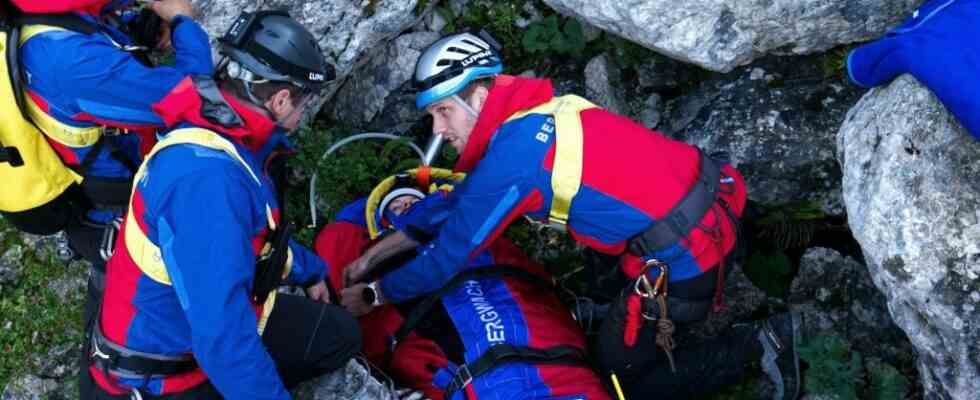Two hikers go to the mountains. It’s already April and everything in the valley is beginning to bloom. Even at an altitude of 1600 meters, winter seems to be over, but that changes a little later. The path is suddenly full of snow, a storm is brewing. The two hikers can go no further and they cannot go back either. They alert the mountain rescue service. But because of hurricane winds, the helicopters cannot fly at night. The next morning, one of the two excursionists is dead. A rescue worker, at the risk of his life, gets the other one out of the wall, who also dies a little later in the hospital. Such missions are for the Mountain Rescue Bavaria no isolated cases. Last winter there was an “above-average number of fatal accidents when hiking and mountaineering”, summed up Klaus Schädler, Managing Director of the Bavarian Mountain Rescue Service, at the annual press conference on Friday in Mountain rescue center Bad Tölz.
The mountain rescue service recorded a total of 5475 missions last winter in the Allgäu and Chiemgau, the mountains in between and in the Bavarian low mountain range. This is about as many as in the years before the corona pandemic, explains Roland Ampenberger, spokesman for the mountain rescue service. As usual, most of these were accidents involving skiers and snowboarders, which at 59.6 percent accounted for almost two thirds of all calls.
The mountain rescue service has to go out much less frequently because of hikers and mountaineers (8.8 percent), tobogganers (four percent) and cross-country skiers (two percent). The statistics also do not support the assumption that the strong trend towards ski touring means more work for mountain rescuers. 127 cases in the past winter season from the beginning of December to the end of April account for just 2.2 percent.
At around 2.2 percent, the operations of the mountain rescue service due to ski tourers are comparatively small. Because of accidents with hikers and mountaineers, she has to turn out four times as often.
(Photo: Robert Haas)
However, the rescue workers are more concerned about hikers and mountaineers. There were 19 deaths, said Klaus Schädler, Managing Director of the Bavarian Mountain Rescue Service. “That’s more than the cut.” However, seven of them did not die as a result of the tour itself, but “internal cases”. For comparison: In the winter of 2017/18 there were only nine cases. The number of hikers who got into mountain distress but remained unharmed has also increased significantly. The mountain rescue service recorded 205 such missions, four years ago there were only 106.
According to Jürgen Brummer, the deputy chairman of the Bavarian Mountain Rescue Service, the dangers in the mountains are not recognizable for some people in the digital world of images. “We keep finding that we have to reach people.”
(Photo: Manfred Neubauer)
These are people who get stuck in the mountains in winter and then alert the rescuers. In principle, this is correct, said Schädler, who therefore does not necessarily want to assume that such callers have a fully comprehensive mentality. However: “People no longer deal with the subject of mountains.” The dangers that trained mountaineers know about are not recognizable to them. This is also due to Instagram, Facebook and other social media.
Jürgen Brummer, deputy chairman of the Bavarian Mountain Rescue Service, made a very similar statement. “The ease of digital imagery on social media often suggests the ubiquitous availability and feasibility of summit goals, regardless of all other factors and personal abilities,” he said. According to Ampenberger, some people completely lack “the perception, recognition and acceptance of differences between winter and summer conditions”.
The mountain rescue service therefore urgently recommends acquiring the necessary knowledge through courses offered by the German Alpine Association (DAV), the international ski association FIS or by experienced mountain guides. “The ability is the measure allowed,” Ampenberger quoted the free climber Peter Preuss.
The looks at an accident-prone winter avalanche warning center return. There were 13 accidents in the mountains due to avalanches, four people died – one of them on the Prinzkopf am Sylvensteinspeicher. The cold season was anything but snowy. That’s why, explained Christoph Hummel from the avalanche warning center. Due to the lack of many flakes, there was an unstable snowpack build-up, and it was also windy and stormy. “The wind is the master builder of avalanches.”
After a mild start to the winter, two “distinctive fresh snow events” with sometimes hurricane winds between the end of January and the end of February led to many avalanche accidents. Wet snow is still to be expected in the Alps, especially in the second half of the day. Hummel can see that the mountains are increasingly becoming an amusement park simply by accessing the avalanche situation report on the Internet. The clicks have now increased significantly to around 2.5 million, he said. “This is evidence of much larger activities in the field.”

